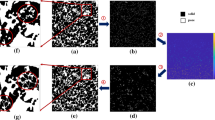Abstract
Tribological mechanism of the diatom frustule with multi-layers of pores is studied with the liquid–solid interaction (FSI) method. Based on the reconstructed representative Coscinodiscus sp. frustule with two-layer porous structure, the tribological performances for the diatom frustule at its different pore diameter ratios, pore depth ratios, and velocities are solved through governing equations involved with FSI method. The numerical result shows that the existence of the two-layer porous structure of the diatom helps to reduce the friction between it and ambient water, and to increase its ability to resist the ambient water pressure. The two-layer porous structure effectively improve the tribological performances for the diatom frustule due to the change in the frustule velocity.














Similar content being viewed by others
References
Mann DG, Droop SJM (1996) Biodiversity, biogeography and conservation of diatoms. Hydrobiologia 336(1–3):19–32
Dickerson MB, Sandhage KH, Naik RR (2008) Protein and peptide-directed syntheses of inorganic materials. Chem Rev 108(11):4935–4978
Bozarth A, Maier UG, Zauner S (2009) Diatoms in biotechnology: modern tools and applications. Appl Microbiol Biot 82(2):195–201
Losic D, Mitchell JG, Voelcker NH (2009) Diatomaceous lessons in nanotechnology and advanced materials. Adv Mater 21(29):2947–2958
Dimas LS, Buehler MJ (2012) Influence of geometry on mechanical properties of bio-inspired silica-based hierarchical materials. Bioinspiration & Biomimetics, 7(3) doi: 10.1088/1748-3182/7/3/036024
Zhang DY, Wang Y, Cai J, Pan J, Jiang X, Jiang Y (2012) Bio-manufacturing based on the micro and nano structures of diatom. Chin Sci Bull 57(24):2249–2263
Gebeshuber IC, Thompson JB, Del Amo Y, Stachelberger H, Kindt JH (2002) In vivo nanoscale atomic force microscopy investigation of diatom adhesion properties. Mater Sci Tech-Load 18(7):763–766
Kroger N (2007) Prescribing diatom morphology: toward genetic engineering of biological nanomaterials. Curr Opin Chem Biol 11(6):662–669
Losic D, Pillar RJ, Dilger T, Mitchell JG, Voelcker NH (2007) Atomic force microscopy (AFM) characterization of the porous silica nanostructure of two centric diatoms. J Porous MAT 14(1):61–69
Hamm CE, Merkel R, Springer O, Jurkojc P, Maier C, Prechtel K, Smetacek V (2003) Architecture and material properties of diatom shells provide effective mechanical protection. Nature 421(6925):841–843
Losic D, Short K, Mitchell JG, Lal R, Voelcker NH (2007) AFM nanoindentations of diatom biosilica surfaces. Langmuir 23(9):5014–5021
Sen D, Buehler MJ (2011) Structural hierarchies define toughness and defect-tolerance despite simple and mechanically inferior brittle building blocks. Nat Sci Rep 1:35–41
Young AM, Karp-Boss L, Jumars PA, Landi EN (2012) Quantifying diatom aspirations: mechanical properties of chain-forming species. Limnol Oceanogr 57(6):1789–1801
Garcia AP, Sen D, Buehler MJ (2011) Hierarchical silica nanostructures inspired by diatom algae yield superior deformability, toughness, and strength. Metall Mat Trans A Phys Metall Mat Sci 42(13):3889–3897
Parkinson J, Gordon R (1999) Beyond micromachining: the potential of diatoms. Trends Biotechnol 17(5):190–196
Gebeshuber IC, Craford RM (2006) Micromechanics in biogenic hydrated silica: hinges and interlocking devices in diatoms. Proc IMechE, Part J: J Eng Tribol 220(8):787–796
Gebeshuber IC, Stachelberger H, Drack M (2005) Diatom bionanotribology—biological surfaces in relative motion: their design, friction, adhesion, lubrication and wear. Nanosci Nanotechnol 5(1):79–87
Gebeshuber IC, Kindt JH, Thompson JB, Del Amo Y, Stachelberger H, Brzezinski MA, Stucky GD, Morse DE, Hansma PK (2003) Atomic force microscopy study of living diatoms in ambient conditions. Microsc 212:292–299
Toyoda K, Williams DM, Tanaka J, Nagumo T (2006) Morphological investigations of the frustule, perizonium and initial valves of the freshwater diatom Achnanthes crenulata Grunow (Bacillariophyceae). Phycol Res 54(3):173–182
De Stefano M, De Stefano L (2005) Nanostructures in diatom frustules: Functional morphology of valvocopulae in Cocconeidacean monoraphid taxa. Nanosci Nanotechnol 5(1):15–24
Zhang YB, Chen Y, Shi L, Li J, Guo ZG (2012) Recent progress of double-structural and functional materials with special wettability. J Mater Chem 22(3):799–815
Meng FM, Gao GX, Li TT (2014) Investigation of tribological performances for porous structure of diatom frustule with FSI method. Adv Condens Matter Phys. doi:10.1155/2014/205986
Round FE, Crawford RM, Mann DG (1990) Diatoms: biology and morphology of the genera. Cambridge University Press, Cambridge, pp 301–302
Acknowledgments
The authors would like to express their gratitude for the support from the Natural Science Foundation of P.R. China (Contract no. 51375509), the Fundamental Research Funds for the Central Universities of P.R. China (Contract no. CDJZR12248801), and program for New Century Excellent Talents of Ministry of Education of P.R. China (Project no. NCET-10-0881).
Author information
Authors and Affiliations
Corresponding author
Rights and permissions
About this article
Cite this article
Meng, F., Gao, G. & Jia, Z. Study on Tribological Mechanism for Multi-layer Porous Structure of Diatom Frustule. Microb Ecol 69, 45–58 (2015). https://doi.org/10.1007/s00248-014-0485-3
Received:
Accepted:
Published:
Issue Date:
DOI: https://doi.org/10.1007/s00248-014-0485-3




